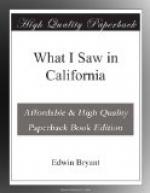or have no crew to do it for them. Some vessels
continue to go to sea, with small crews, at 50 dollars
per month for green hands. Old hands are too
wise for them, and prefer digging an ounce or two
a-day, and drinking hock and champagne at half an ounce
a-bottle, and eating bad sea bread at 1 dollar per
pound. I have seen a captain of a vessel, who,
by his old contract in the port whence he sailed,
was getting 60 dollars per month, paying his cook 75
dollars, and offering 100 dollars per month for a
steward; his former crew, even to his mates, having
gone a ‘prospecting.’ Uncle Sam’s
ships suffer a little the same way, although they
offer from 200 to 500 dollars for the apprehension
of a deserter. The Ohio, however, laid in the
port of Monterey about a month, and lost only 20 or
30 men. Colonel Stevenson’s regiment is
disbanded, 99 out of 100 of whom have also gone ‘prospecting,’
including the colonel, who arrived in Monterey last
month, from his last post, and was met by his men
at the edge of the town, to escort and cheer him into
the town. The captains,
etc., have bought
up country carts and oxen, turned drivers, and gone
to the Placer. Our worthy governor, Colonel of
the 1st Dragoons,
etc., having plenty of carts,
wagons, horses, and mules, with a few regulars left,
has also gone, but under better advantages, for the
second or third time, to see the Placer and the country,
and have justice done to his countrymen or himself.
Commodore Jones, lately arrived in Monterey, supposed
it to be the capital, head-quarters,
etc., but
found not even the Governor left. Where head-quarters
are may be uncertain, whether in Monterey, Sutter’s
Fort, or in a four-mule wagon travelling over the gold
region. Now, whether headquarters are freighted
with munitions of war,
etc., or whether the cargo
consists of blankets, shirts,
etc., to clothe
the suffering Indians, for the paltry consideration
of gold, no one cares or knows; but the principle
should be, that, if privates can or will be off making
their thousands, those who are better able should not
go goldless.”
The Washington Union contains a letter from
Lieutenant Larkin, dated Monterey, November 16, received
at the State Department, containing further confirmation
of the previous despatches, public and private, and
far outstripping all other news in its exciting character.
The gold was increasing in size and quality daily.
Lumps were found weighing from one to two pounds.
Several had been heard of weighing as high as 16 pounds,
and one 25 pounds. Many men, who were poor in
June, were worth 30,000 dollars, by digging and trading
with the Indians. 100 dollars a-day is the average
amount realized daily, from July to October.
Half the diggers were sick with fevers, though not
many deaths had occurred among them. The Indians
would readily give an ounce of gold for a common calico
shirt; others were selling for ten dollars each in
specie. The gold region extends over a track of




